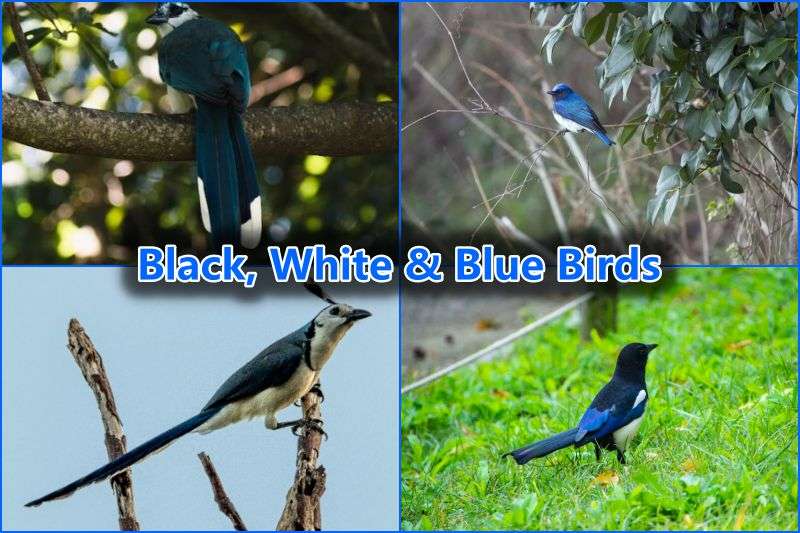Today we have come up with another exciting and mind-boggling post on 15 Tricolor Birds: Black, White, and Blue All Over! This post is going to have all the scintillating content about these tricolor birds, their pictures, and their info.
Tricolor birds included in this list have different shapes, sizes, and habits; where some have general characteristics, others are strangely unique in their habits. We are confident that you will thoroughly enjoy this article!
15 Black, White & Blue Birds
1) Black-billed magpie
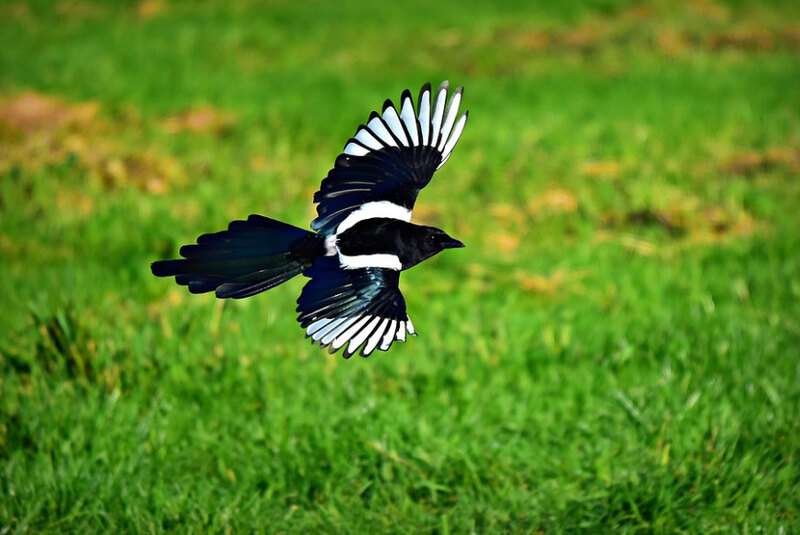
|
Scientific Name |
Pica hudsonia |
|
Size |
45–60 cm (18–24 in) |
|
Diet |
Insects, seeds, carrion, rodents, berries, nuts, and eggs. |
|
Life Span |
4-6 years |
|
Geographic Location |
Western half of North America |
First, on the list of Black, White & Blue Birds is one of the species of intelligent magpies, the Black-billed Magpies.
Black-billed Magpies, also known as American magpies, which are bigger and flashier relatives of crows and jays, are very social and pretty vocal birds and are usually seen in flocks.
To illustrate, they have a dark black head, accompanied by black shoulders and chest, and a long, black bill.
Also, they have white plumage on the belly and white patches on the shoulder; they have blue-black, diamond-shaped tails that appear to be shiny greenish-blue when seen in daylight; and the lower plumage on the back is pale black too.
The nests of these birds are huge, and it takes them 40 days to construct a single nest; moreover, they are also nest predators and consume eggs and nestlings besides their usual diet.
You have certainly seen them on the backs of deer and moose, picking out any possible ticks resting there.
2) Tree swallow

|
Scientific Name |
Tachycineta bicolor |
|
Size |
12 and 14 cm (4.7 and 5.5 in) |
|
Diet |
Insects, spiders, molluscs, and fruit |
|
Life Span |
2.7 years |
|
Geographic Location |
North America, the Northern Pacific, the Arctic Circle, Greenland, and Europe |
Tree swallows are North American migratory birds named after their habit of nesting in tree cavities, despite the fact that they are frequently seen in large flocks of hundreds to thousands.
Tree swallows are Black, White & Blue Birds, having eye-catching, glossy plumage that shines beautifully in the light.
Their head, top, and back plumage are metallic blue, coupled with deep black flight wings and a black, notched tail.
Another key point is that they have frosty white underparts that extend up to their faces below their tiny, black beak.
They inhabit marshes or open fields adjoining freshwater bodies, have nest boxes, and are also often found perching on wires and shrubs.
Nonetheless, they can even feed on insects while being in the air, which is why they are also known as aerial insectivores.
3) Blue jay
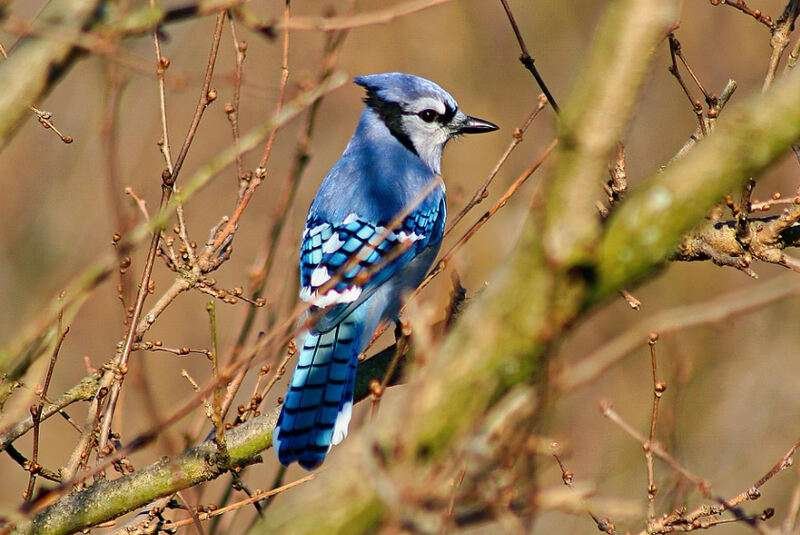
|
Scientific Name |
Cyanocitta cristata |
|
Size |
22–30 cm (9–12 in) |
|
Diet |
Vegetables matter, seeds, nuts, grains, and corn |
|
Life Span |
7 years |
|
Geographic Location |
Southern Canada, the eastern and central United States, and northeastern Texas |
Blue Jays are large songbirds known for their complex social systems, their intelligence, and their solid family bonding.
Blay jays have distinctive, perky crests that can be worn up or down.
They have a bright blue head, back, and wings in contrast to a white face and belly, as well as a distinctive black bridle across their chest and more or less framing their face and nape; this bridle varies greatly among specimens and aids in identification.
They have blue wings overlaid with bold white patches and black bars and have a barred black and blue tail.
Furthermore, they have been observed imitating hawk calls in order to warn or alert their fellow birds of any hawk that may be nearby, as well as to deceive other species of birds into believing that a hawk is nearby.
Their migrations are mostly mysterious, and young blue jays migrate more often in comparison to their adults.
4) Indigo buntings
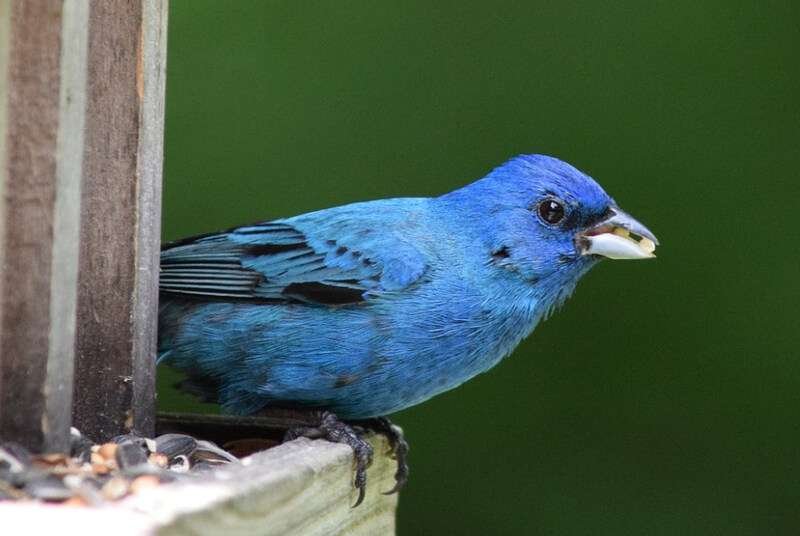
|
Scientific Name |
Passerina cyanea |
|
Size |
11.5–15 cm (4.5–5.9 in) |
|
Diet |
Insects, grass seeds, berries, and buds. |
|
Life Span |
Up to 10 years |
|
Geographic Location |
Southern Canada, northern Florida, southern Florida, and northern South America |
Indigo Buntings are also nicknamed “blue canaries” because of their brilliantly colored plumage that looks like a scrap of the majestic sky.
They are very common and widespread songbirds and dwell in shrubby areas, locating nearby trees and weedy fields and specifically singing on top of the tallest perch from dawn until dusk.
Breeding males have brighter indigo heads, sapphire blue on the rest of their bodies, and patchier white plumage while females have more of a rufous look with brown plumage and a streaked white throat and lower parts of the belly.
Both sexes have a silvery-white conical bill with black streaks on the lower wings and near flanks.
Surprisingly, they migrate at night, unlike many other birds, and use the stars’ guidance, adjusting their orientation angle to match that of the stars because they, too, move through the night sky.
5) Barn swallow
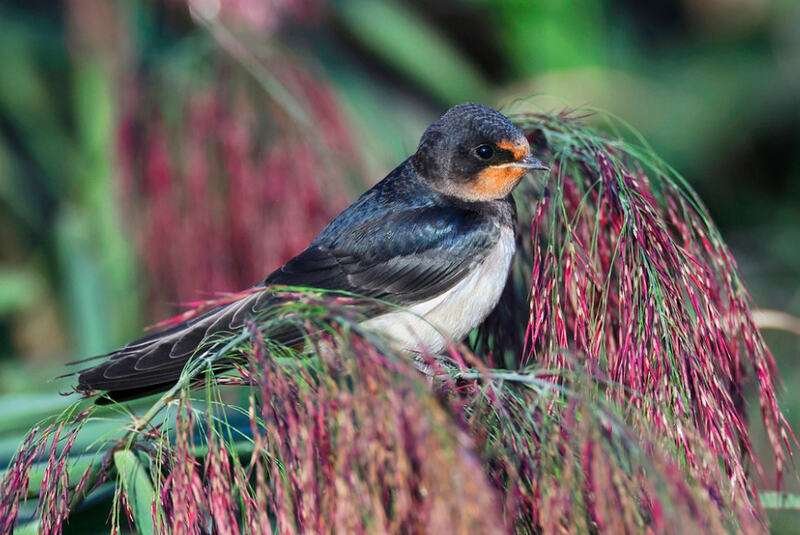
|
Scientific Name |
Hirundo rustica |
|
Size |
17–19 cm (6.5–7.5 in) |
|
Diet |
All types of Insects, mainly flies. |
|
Life Span |
Up to 4 years |
|
Geographic Location |
Africa, Europe, Asia, and the Americas |
Barn swallows are the most widespread species compared to other species of swallows and have the enormous distribution, ranging over 251 million square kilometers all around the globe.
They have distinctively long, fork-shaped, black tails and broad, pointed, brown-black and cobalt blue wings and a small black beak.
They have a metallic blue head, shoulders, and upper-parts and tawny, rusty-brown under-parts.
Barn swallows used to build their cup-shaped nests in caves, but now they almost exclusively build them in man-made structures and frequently get help feeding their newborns from their older babies.
Another remarkable habit of unmated males of these species is killing the nestlings of a couple, which leads to the breakup of the nesting pair and gives him the opportunity to mate with the female.
6) Collared kingfisher
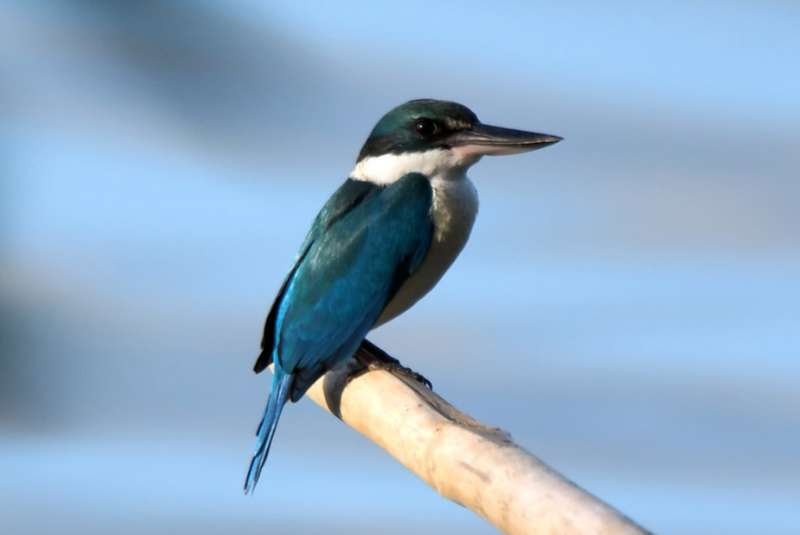
|
Scientific Name |
Todiramphus chloris |
|
Size |
23 to 25 cm (9.1 to 9.8 in) |
|
Diet |
Insects, small crabs, shrimp, spiders, earthworms, frogs, snails, lizards, and small fish, as well as small snakes and birds. |
|
Life Span |
6-11 years |
|
Geographic Location |
Western Eurasia or Africa, Polynesia and southern Asia. |
Collared Kingfishers are medium-sized kingfishers in the tree kingfisher family.
Because of their characteristics, they are also known as white-collared kingfishers, mangrove kingfishers, and black-masked kingfishers.
As their nickname suggests, they have a distinctive white collar, which is more evident at the nape and bordered by a tapered black line.
They have a turquoise head and greenish blue plumage outlined by narrow black lines. Kingfishers are excellent fishermen and use their hard, black-colored, dagger-like bills for spearing fish.
Above all, they are undeniably aggressive, specifically during nesting, towards other specimens and kingfishers of other species too, and are seen snatching food items.
7) Blue-and-white flycatcher
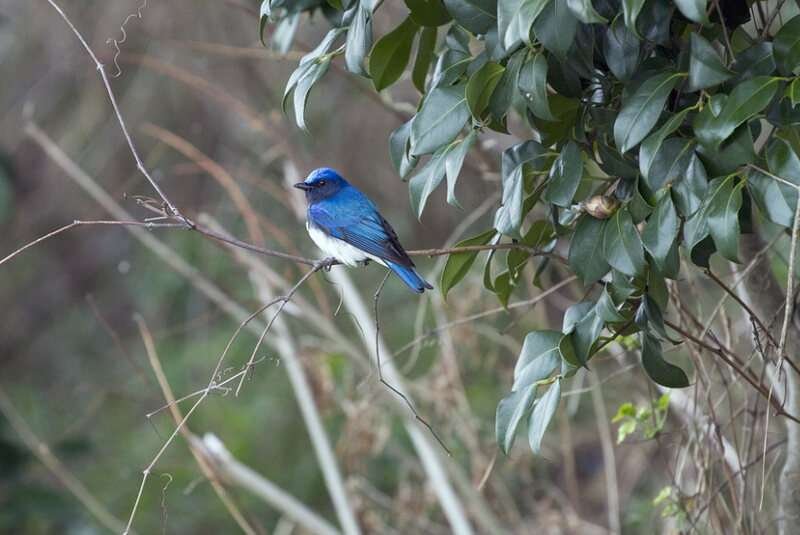
|
Scientific Name |
Cyanoptila cyanomelana |
|
Size |
17–21 cm (6.7–8.3 in) |
|
Diet |
Insects, Larvae, and berries, such as unripe green berries. |
|
Life Span |
Up to 10 years |
|
Geographic Location |
Japan, Korea, Northeastern China, Vietnam, and far east in Russia |
Blue-and-white flycatchers are migratory songbirds that belong to the old world family of flycatchers.
These birds are quite strikingly colored in beautiful colors; they have electric blue-colored plumage on the crown, shoulders, and back, coupled with black plumes on the wings.
Their bill and throat are black, with a snowy-white belly and undertail coverts.
Males sing melodious songs to attract potential females, but they are also known for their miserable-sounding whistle tunes, which are short and crisp.
Finally, I want to mention that they live in submontane and wooded lowlands and migrate to more open areas during the winter.
8) Blue-winged kookaburra
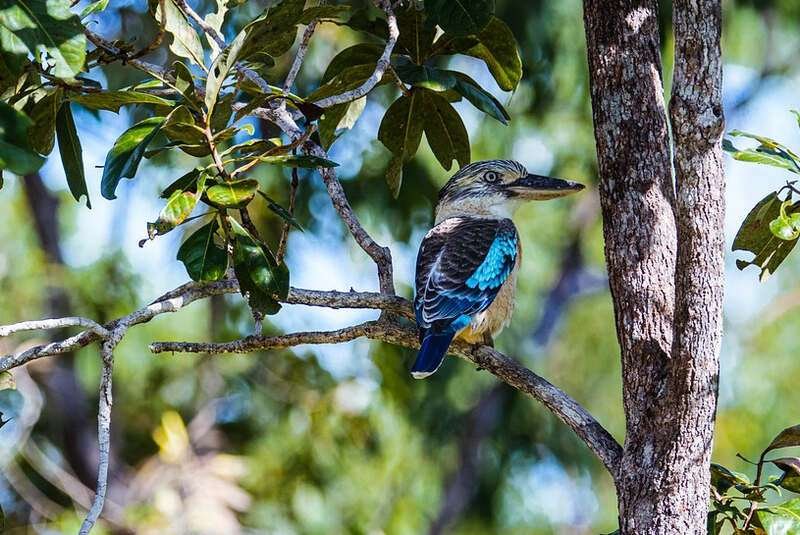
|
Scientific Name |
Dacelo leachii |
|
Size |
38 to 42 cm (15 to 17 in) |
|
Diet |
Insects, frogs, lizards, earthworms, fish, and arthropods, as well as small birds and rodents |
|
Life Span |
Up to 20 years or more |
|
Geographic Location |
Southern New Guinea and northern Australia. |
Blue-winged kookaburras seem very similar to laughing kookaburras, but they are slightly smaller than them and reside in coastal and subcoastal areas, as well as tropical and subtropical open woodlands, timbered areas, watercourses, paperback swamps, canefields, and farmlands.
Blue-winged kookaburras are magnificent birds with vivid colors and have a huge, square-shaped head and a long, flat-shaped bill.
Their heads are cream-colored with black or brown lines and shiny azure blue plumage on the rump and outer wings, accompanied by brownish-black plumage on the top; additionally, they have creamish white undersides and a white nape and throat.
Differentiation between sexes can be done on the basis of their tail colors; males have deep blue tails, while females have barred brown or black tails.
9) Eurasian Magpie
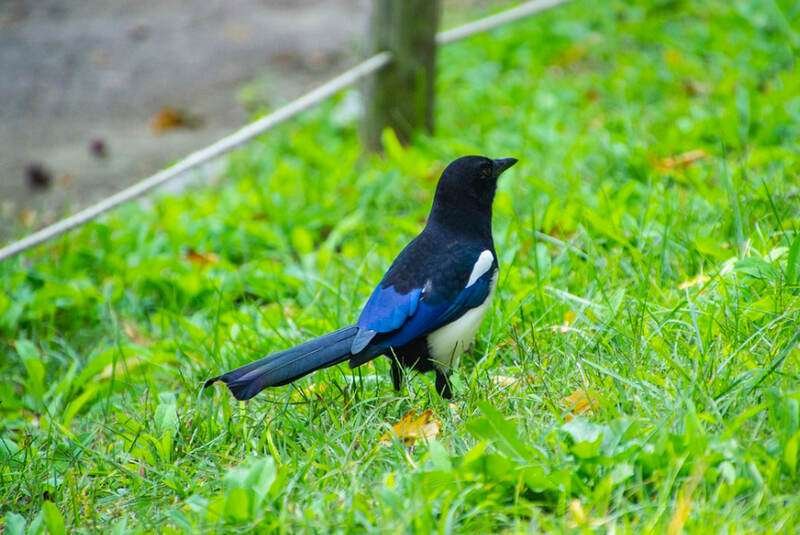
|
Scientific Name |
Pica pica |
|
Size |
44–46 cm (17–18 in) |
|
Diet |
Young birds, bird eggs, small mammals, scraps, carrion, acorns, grains, insects, and other vegetables matter. |
|
Life Span |
3.7 years |
|
Geographic Location |
Northern parts of Eurasia |
Eurasian Magpies have braincases that are relatively larger than their bodies, suggesting a high level of intelligence; their brain-to-body mass ratio is only dominated by that of humans and is almost equal to that of great apes and aquatic mammals.
They have a completely black head, neck, throat, and top, as well as contrasting white plumage ventrally and on the flanks.
They have indigo-blue flight feathers and a long, diamond-shaped tail colored in shades of olive green and purple with black present on the edges.
Their intelligence can be measured by their ability to recognise themselves in mirrors and to engineer tools for a variety of purposes, such as predicting the behavior of other specimens, hiding and storing food, and accurately piecing food into the correct proportions for their young.
10) Blue-black Kingfisher
|
Scientific Name |
Todiramphus nigrocyaneus |
|
Size |
23 cm (9.1 inches) |
|
Diet |
Lizards, crabs, and fish. |
|
Life Span |
Up to 15 years |
|
Geographic Location |
New Guinea and offshore islands of Salawati, Batanta and Yapen. |
Blue-black Kingfishers are medium-sized Black, White & Blue Birds found in forested streams or mangroves located in the lowlands.
Because of the logging of lowland swampy forests and the degradation of water quality caused by various pollutants, this species of kingfisher is quite rare and endangered.
They have a striking navy blue head encircled by a broad black band that covers the nape and extends all the way back to the flight feathers, forming a saw-shaped pattern on the flanks.
The ventral side is either deep blue with a distinctive white stripe across the chest or white with a deep blue-colored band across the chest.
While in flight, a lighter, neon-colored, diamond-like shape flash is visible above their square tails.
11) Forest Kingfisher

|
Scientific Name |
Todiramphus macleayii |
|
Size |
21.5–25.5 cm (8.5–10.0 in) |
|
Diet |
Invertebrates, worms, frogs, tadpoles, and lizards, as well as small fishes and snakes. |
|
Life Span |
Up to 15 years |
|
Geographic Location |
New Guinea, Indonesia, and Eastern and Northern Australia |
Forest Kingfishers are more commonly referred to as “blue kingfishers” or “Macleay’s.”
They resemble collared kingfishers in appearance because of their similar coloration and white collar across their neck, which at times is broken by an extension of the blue color of their heads, but they are lightly colored and appear brighter than them.
They have black cheeks, and their upper wings are consecutively colored in olive green wings overlaid upon blue wings, which are again overlaid upon their innermost black wings.
Furthermore, they have snowy white undersides and white cere upon their elongated, triangular, chisel-shaped black bill.
They are deadly birds and are known to kill their prey by hitting it hard against the bark of the tree.
12) Cerulean Warbler

|
Scientific Name |
Setophaga cerulea |
|
Size |
11 cm (4.3 in) |
|
Diet |
Insects such as flies, weevils, beetles, and caterpillars. |
|
Life Span |
Up to 6 years |
|
Geographic Location |
Eastern North America and South America. |
Cerulean warblers are small songbirds and long-distance migrants that are seen hopping in the sky through the higher canopies of forests from down below. These birds got their name from their cerulean blue plumage.
Blue plumage with white bars on the wings and blue-black streaked plumage on the rump. Black broken streaks are also seen on the flanks in males, which are absent in females, along with a very fine stripe present across the neck of males.
Cerulean warblers are seen bungee-jumping from their nest as they take off for flight; they fold their wings and drop from the edge of their nest straight down and only fly once they are well distant from their nests.
13) Male Belted Kingfisher

|
Scientific Name |
Megaceryle alcyon |
|
Size |
28–35 cm (11–14 in) |
|
Diet |
Fish, small crustaceans, small mammals, small reptiles, and insects. |
|
Life Span |
Up to 15 years. |
|
Geographic Location |
North America |
Belted Kingfishers are huge, remarkable water birds that inhabit ponds, streams, rivers, lakes, and estuaries and dig nests in water banks.
Males are conspicuously grayish-blue and have a large, pointed crest in addition to a long, pointed, flat bill. They even have a white collar above their bluish-grey breast band.
Moreover, males do not have any stripes on them, unlike females, who have a brownish belt-like band across their bellies, from which they get their name. They are loners and perch alone near the edges of the water source.
14) Black-throated Magpie-Jay
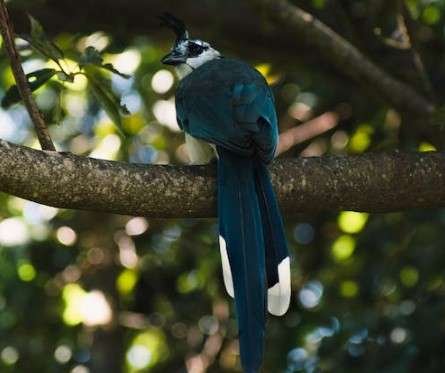
|
Scientific Name |
Calocitta colliei |
|
Size |
58.5 to 76.5 cm (23 to 30 inches) |
|
Diet |
Insects, nuts, seeds, and even the chicks of other birds species |
|
Life Span |
15-25 years |
|
Geographic Location |
Baja Peninsula in Northwestern Mexico |
Black-throated magpie-jays are a hybrid of magpies and jays and one of the only two species of magpie-jays located in the dry and sub-humid forests of Northwestern Mexico. They are extroverted but monogamous birds that are utterly vocal.
Black-throated magpie-jays have more expansive black crests and black throats and heads in comparison to their white counterparts.
They have very elongated, fork-shaped, navy blue tails and upper blue-gray plumage contrasting with full white undersides. A black band is seen on the underside of their tails while they fly.
The specimens are known to gang up together to frighten their predators and have a unique way of eating by standing on one foot and eating through the other foot.
15) White-throated Magpie-jay
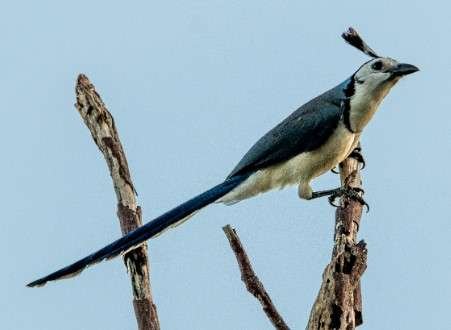
|
Scientific Name |
Calocitta formosa |
|
Size |
51 cm (20 in) |
|
Diet |
Insects, primarily caterpillars and small fruits. |
|
Life Span |
15-25 years |
|
Geographic Location |
Mexico and Central America |
White-throated magpie-jays are Black, White & Blue Birds and a hybrid species of magpie-jays, which are quite easy to locate because of their loud nature and habit of living and flying in groups. Anyone can easily spot them in the wilderness.
White-throated magpie-jays have more wavy and curvy crests than their counterparts and are distinguished by the presence of a white throat, which is outlined by a narrow black band. It looks like their faces are framed by a black border.
They have a long, trailing tail and nearly identical plumage colors to the black-throated magpie-jays.
Conclusion:
Nonetheless, these tricolored birds or Black, White & Blue Birds are truly unique and adorable, and some of them could make really nice pets.
We hope this article helped you expand your knowledge about these birds and made it easier for you all to identify and name them from now on. These Black, White & Blue Birds gave twitchers a spectacular show in terms of their brilliant looks.
Also Read:

Hey there! I’ve been the kid who used to love watching all the science stuff and that fascination lead me to choose Zoology as my Major in Graduation. I’m a self-taught writer and spend my time writing scintillating content on animals. I love observing animals behavior and their bond with humans. I want to give my point of view regarding animals i research about. I had done several projects on animals during my graduation and learned their behavior thoroughly.
